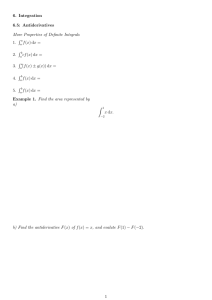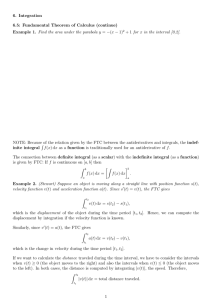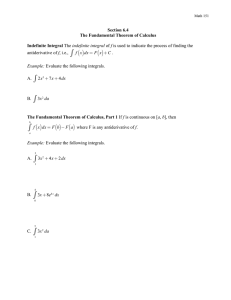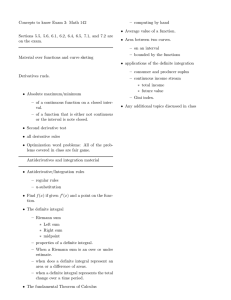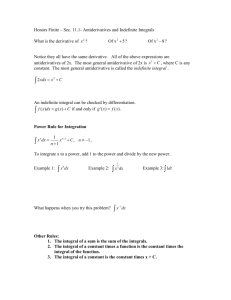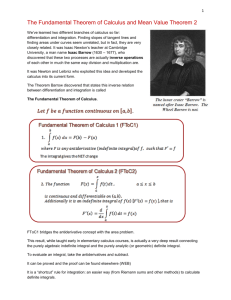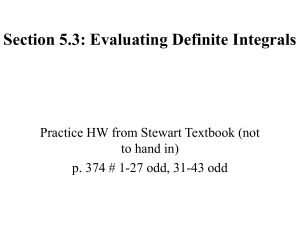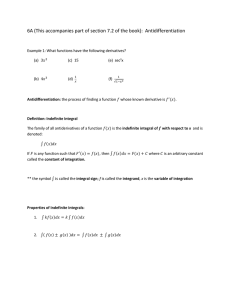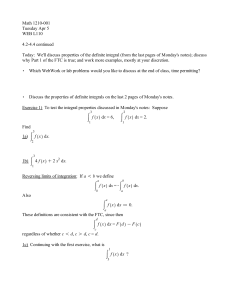Math 142 Business Mathematics II Minh Kha
advertisement
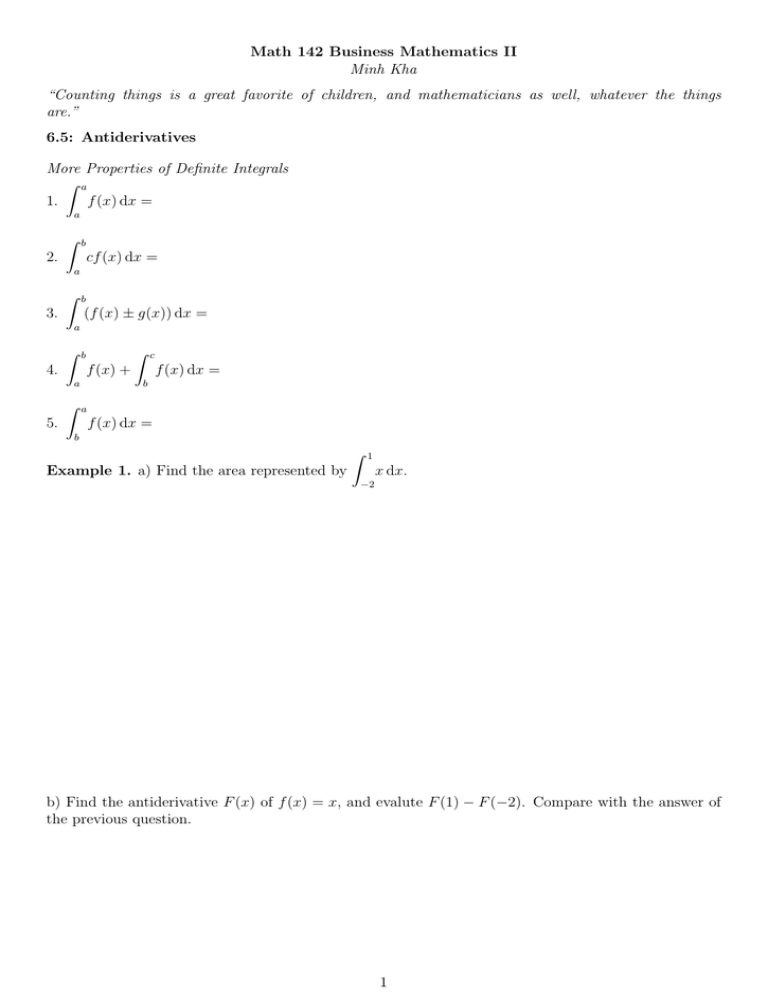
Math 142 Business Mathematics II Minh Kha “Counting things is a great favorite of children, and mathematicians as well, whatever the things are.” 6.5: Antiderivatives More Properties of Definite Integrals Z a f (x) dx = 1. a Z b 2. cf (x) dx = a Z b (f (x) ± g(x)) dx = 3. a Z b Z c f (x) dx = f (x) + 4. b a Z 5. a f (x) dx = b Z 1 Example 1. a) Find the area represented by x dx. −2 b) Find the antiderivative F (x) of f (x) = x, and evalute F (1) − F (−2). Compare with the answer of the previous question. 1 Fundamental Theorem of Calculus, Part 1: Let f be a continuous function on [a, b]. We consider the following function Z x f (t)dt, a ≤ x ≤ b. g(x) = a Then g is continuous on [a, b] and differentiable on (a, b), and g 0 (x) = f (x). In short, we have d dx Z x f (t)dt = f (x). a OR in words, roughly speaking, taking derivative of an integral will give back the original function. Example 2. Evaluate the derivative of the following functions: a) Z x (t3 + 1)2 dt g(x) = 1 b) Z h(x) = x 2 t2 1 dt +1 Fundamental Theorem of Calculus (Part 2): Suppose f is a continuous function defined on a closed interval [a, b], then Z b f (x) dx = F (b) − F (a) a where F is any antiderivative of f . In words, taking a definite integral of a function over in an interval will give the difference over the same interval of the antiderivative of that function.. Remark 0.1. FTC part 1, 2 describe directly relations between derivative, integrals, and antiderivatives. That somehow explains the name of the theorems! Because Rof the relation given by the FTC between the antiderivatives and integrals, the indefinite integral f (x) dx as a function is traditionally used for an antiderivative of f . The connection between definite integral (as a scalar) with the indefinite integral (as a function) is given by FTC: If f is continuous on [a, b] then Z x=b Z b f (x) dx = f (x) dx . a x=a 2 Example 3. Evaluate the following integrals: a) 3 Z e3x dx −2 b) Z 1√ 6 2x + 5 dx −1 3 c) 5 Z 0 1 dx 7x + 1 d) Z 0 1 1 dx (2 − x)2 4 e) Z 1 0 x2 Z 5 x+2 dx + 4x + 3 f) | − x + 7| dx −5 5 6.5: More on fundamental theorem of calculus and some applications Example 4. Find the area under the parabola y = −x2 + 1 for x in the interval [-1,1]. Remark 0.2. (Stewart) Suppose an object is moving along a straight line with position function s(t), velocity function v(t) and acceleration function a(t). Since s0 (t) = v(t), the FTC gives Z t2 v(t) dx = s(t2 ) − s(t1 ), t1 which is the displacement of the object during the time period [t1 , t2 ]. Hence, we can compute the displacement by integration if the velocity function is known. Similarly, since v 0 (t) = a(t), the FTC gives Z t2 a(t) dx = v(t2 ) − v(t1 ), t1 which is the change in velocity during the time period [t1 , t2 ]. If we want to calculate the distance traveled during the time interval, we have to consider the intervals when v(t) ≥ 0 (the object moves to the right) and also the intervals when v(t) ≤ 0 (the object moves to the left). In both cases, the distance is computed by integrating |v(t)|, the speed. Therefore, Z t2 |v(t)| dx = total distance traveled. t1 6 Example 5. An object moves along a line so that its velocity at time t is v(t) = 8t + 1 where position is given in meters and t is given in seconds. a) Find the displacement of the particle during the time period [0, 2]. b) Find the distance traveled during the this time period. Average value of a function DEFINITION: The average value of a continuous function f on the interval [a, b] is given by Z b 1 f (x) dx. b−a a Example 6. Find the average value of the following function on the given interval. a) f (x) = 9 on [1,10]. b) f (x) = 2x2 + x − 5 on [-1,1]. 7
